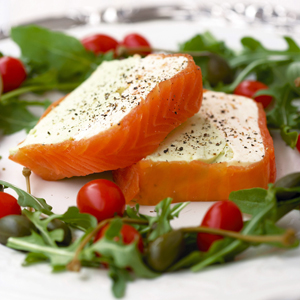There’s really no great difference between a pate and a terrine (the
latter is named for the ‘mold’ it is made in), except that a terrine is
usually less formal and never has a crust, whereas a pate might have
one. Also, a terrine is often seen as a mixture of different pates.
When you get right down to it, both are closely related to meat loaf.
But terrines and pates are most often served cold or at room
temperature and that’s what makes them ideal for a light dinner when
accompanied by some good bread and cheese and fruit or hearty salads.
Of course you get sweet terrines too, so try our recipes below if you
feel like a real treat.
When making terrines:
content, including any
lining, in a meat terrine
above 40 percent,
otherwise it will be dry.
Fat is an essential
ingredient. For this reason,
ask your butcher in the
supermarket to slice the
‘fat back’ or pork fat for
you. It will make lining a
mould easier, and is less
expensive than bacon.
If you want to see
texture and marbling
when you slice a terrine,
chop ingredients finely
and mix by hand.
Texture will be lost using
a food processor.
more seasoning than you
think reasonable. This
is because the taste
becomes muted once
the pâté or terrine is
cold, and without the
extra seasoning, the
flavour can be bland.
to drape over the sides
of a mould, giving you
enough to cover the top
when the terrine is filled.
The container should
be filled to about 5cm
above the rim to allow
for shrinkage during
cooking. Cover the top
with the fat or bacon and
decorate with bay leaves.
double layer of foil and put
the terrine in a baking dish,
filled with hot water that
comes halfway up the side.
This ensures even cooking.
terrine is ready, pierce with
a knife. If cooked, the
juices will run clear and
the terrine will have pulled
away from the side of the
container. Remove from
the water bath and place
a plate or board on top,
adding weight, such as
a brick or tinned food, to
press down the terrine.
This ensures a dense
mixture, which makes it
easier to slice.
hours to cool and
refrigerate for a couple
of days before eating to
allow flavours to develop.
10 things to do with terrines
Brinjal-and-red-pepper terrine

